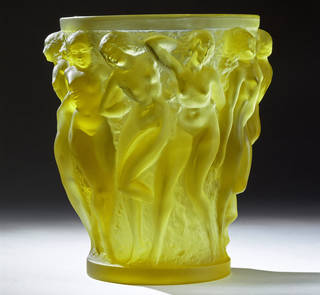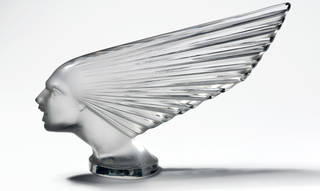An exceptional artist and astute industrialist, René Jules Lalique is considered one of the driving forces of Art Deco. Having enjoyed a fruitful career making jewellery in the Art Nouveau style, he turned his hand to glasswork, producing press-molded Art Deco vases at his factory in Wingen-sue-Moder, in the Alsace region of France. The V&A holds many important examples of his work.
In the mid-1920s, Lalique was at the forefront of commercial design production. His techniques gave rise to a style that celebrated contrasts between clear and frosted glass. Sometimes patinas (surface coatings), enamels or areas of stained glass were added for decorative effect.

After 1925, Lalique introduced a range of colours into his commercial lines. The yellow amber of the Bacchantes vase was made using iron oxides in the glass mass. The figure design was adapted and reused in other works. The Bacchantes theme echoes the Art Deco appetite for Classical imagery.

Although Lalique primarily made small, affordable pieces, he occasionally took on large-scale interior design commissions. In 1928, he was chosen, among a number of other distinguished designers, to decorate the Côte d’Azur Pullman Express train carriages. The V&A holds one of the Lalique window panels, titled 'Blackbirds and Grapes', which was used as a divider between carriages, displaying his signature style of contrasted clear and frosted glass.

Throughout the late 1920s and early 1930s, Lalique also made his mark as a designer of the car mascot. The forerunner of modern hood ornaments, the car mascot was a small decorative item, often mounted on a car's radiator cap. His 'Spirit of the Wind' in cast glass oozes Art Deco flair. A symbol of speed, the bold effect of the mascot's wind-blown hair perfectly captures the dynamism of the machine-age.

Lalique's mass production of innovative, usable art glass was a potent combination. His creations became highly desirable among ordinary people, earning him a reputation as one of the most celebrated glassmakers in the world.


